The Parkmaker's Guide:
Lakes and Ponds
Hmm, there's a small section in your park and you're not sure what to put in it. It's not exactly a good spot to place a building and it's too small to ignore. What do you do? Well, if this sounds familiar, you may be thinking of the Parkmaker's Guide #1: Gap Fillers where I list the many different methods of filling in those annoying spaces.
If I'm right, then you're already familiar with the technique of using the water tool as a means of filling the gap. But is there a right and a wrong way to use it? Should parkmakers be aware of how their ponds and lakes look? Of course they should! That's why I've compiled a small beginner's tutorial explaining how exactly to place an aesthetically pleasing piece of water.
Let's begin with a very bad example of water placement. Notice the picture below.
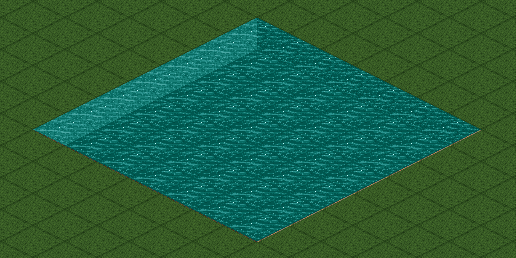
Only one word to say. Ew. This kind of poor quality "pond" makes the average RCTer cringe when looking at it. What you want to go for is a realistic portrayal of a peaceful pond. The screen above is simply a shortcut to disaster. Not a good choice. To improve, let's take the same pond and change it slightly using the hills tool in the scenario editor.
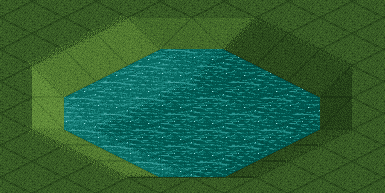
It's a bit better, isn't it? By doing this, we're rid of the square edges and it also follows a simple rule of physics: water always falls downward. Therefore, all bodies of water are lower than the ground surrounding it. The first picture's water level was equal with the ground, which you will never see in nature. The second one has the water level at five feet lower than the regular flat grass. You may choose to lower your level of water, but I feel that this usually suits it best.
However, there is still something wrong with it. Can you spot it? If you can, good work. If you can't, go away and never play RCT again. I'm kidding, but it's rather obvious that the pond still has a general "square" feel to it with the edges cut off. Not too nature-like, eh? Of course not. Try creating a more random shape when creating a pond, lake, or ANY body of water that's not a fountain. Try making small bays and peninsulas or just alter the shape until you feel it's balanced and natural. Utilizing the same space as the first two pictures, I created the below pond.
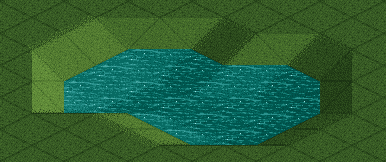
There, much better. This is a pond that you could get away with in your park. It's small, attractive, and an excellent gap filler. And on another note, the same method goes for larger bodies, like lakes or even ocean bays. Having a somewhat "random" shoreline is key to creating that natural-looking water you want.
Also, if you have something larger and want to add a centerpiece, an island just might be what you're looking for. These are incredibly easy to make, but must be done properly if you want it to work. Start by creating a rather large pond or lake.
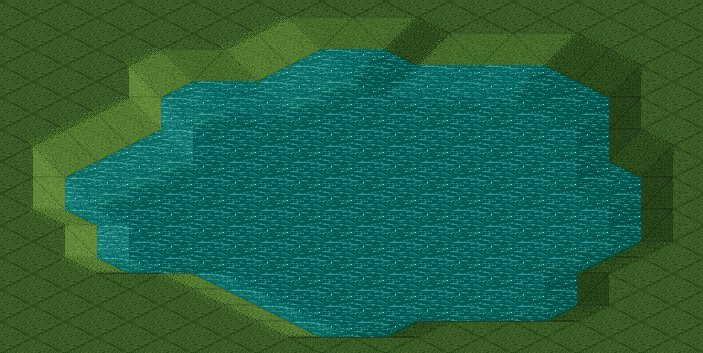
This is a well-shaped lake. It's large and looks like something you could see in the local park. But what's missing? The island, duh! To create an island, use the hill tool in the scenario editor and raise the ground in the middle of the lake above your water level. You have an island! But nevertheless, you still want it to look nice. In order to do this, you must use the same technique you did to create the shoreline. Random and natural. Try to find that correct balance so it accompanies the lake well. Here's what I came up with:

Now, you may be asking, "Ok, that's all good, but how do I theme it?" Theming a pond or lake is a little hard because of the random shoreline. Buildings are difficult to build right next to it and so are paths. Oh yeah! I already have a tutorial that answers this question! Simply use another gap filler! Trees, bushes, and gardens are all very good uses to compensate for the awkward shape of the pond or lake. Here's what I did with some Weeping Willows, European Larches, Hibas, and Walnut Trees:
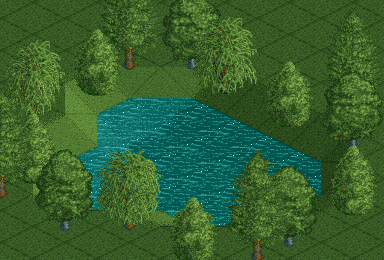
If you use the right methods and techniques, you can find yourself with a charming little lake that everyone loves to look at. Perhaps in the future I will show you how to add rivers, waterfalls, and other water features, but for now, go with ponds, lakes, and don't be afraid to experiment!
Copyright © Steve Welch